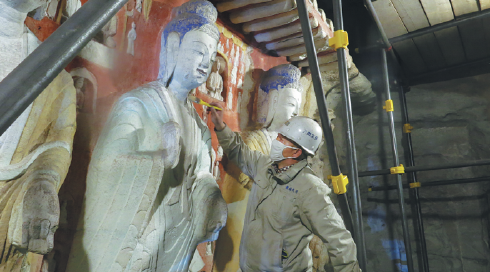Academy to keep interest in grottoes alive
Updated: 2021-02-26

A technician works to preserve the statues at Yungang Grottoes in Shanxi province. [Photo/China Daily]
Yungang heritage site in Shanxi hopes to attract researchers from around the world
Research into the globally renowned cultural heritage site of Yungang Grottoes in Shanxi province is expected to reach new heights with the launch of an academy on Feb 19, said local officials and experts.
Lou Yangsheng, Party secretary of Shanxi province, attended the launch ceremony of the Yungang Grottoes Academy.
He said it represents Shanxi's latest move to protect the cultural heritage site and attract global interest into research of the site.
"We aim to build the academy into an authoritative platform for the research on local Buddhist culture and arts and promote the globalization of Yungang studies," Lou said.
Yungang Grottoes, located in the northern Shanxi city of Datong, is one of the three most famous Buddhist grottoes sites in China. The other two are Mogao Grottoes in Dunhuang, Gansu province, and Longmen Grottoes in Luoyang, Henan province.
Yungang Grottoes was built more than 1,500 years ago during the Northern Wei Dynasty (386-534), when Datong, which was then called Pingcheng, served as the nation's capital.
The grottoes were carved out of sandstone cliffs on Wuzhou Mountain in the northwestern suburbs of Datong.
According to historical documents, a total of 54 main caves were carved out during the period from 460-524. Today, 45 main caves remain intact which house more than 59,000 statues, ranging from a few centimeters to 17 meters in height.
Yungang Grottoes was included on the UNESCO World Cultural Heritage list in 2001.
UNESCO said in a document that the site has a universal value as it represents "the outstanding achievement of Buddhist cave art in China".
While influenced by Buddhist cave art from South and Central Asia, UNESCO said Yungang Grottoes has interpreted Buddhist art with Chinese character and local spirit. "As a result, Yungang Grottoes have played a vitally important role among early Oriental Buddhist grottoes and had a far-reaching impact on Buddhist cave art in China and East Asia."
The grottoes have attracted the attention and interest of overseas scholars since the early 20th century.
Japanese architecture researcher Chuta Ito was among the first foreign scholars who introduced Yungang Grottoes to the world. He published a book on Yungang Grottoes shortly after his research tour of the site in 1902.
Today, Yungang has become a popular destination for researchers and tourists from across the world.
In 2020, despite the COVID-19 pandemic, Yungang Grottoes received 1.46 million visits and netted a revenue of 38.98 million yuan ($6.04 million), according to the culture and tourism bureau of Datong.
After Yungang Grottoes was battered by wind, rain and snow over 1,500 years, protecting this precious cultural heritage site has become a pressing challenge, said Zhang Zhuo, Party secretary of the Yungang Grottoes Academy.
"Cultural heritage protection is a major task of the Yungang Grottoes Academy," Zhang said.
Over the past decade, the Yungang Grottoes Research Institute, the predecessor of the academy, launched a number of programs to protect the site.
One effort was a collaboration with the Getty Conservation Institute based in the United States. In Yungang, collaborative activities included environmental monitoring to assess the extent and effect of weathering due to pollution, wind, rain and extreme temperatures. They also developed a comprehensive conservation plan to prevent deterioration caused by visitors and the environment, according to Zhang.
"We have made progress in preventing damage caused by pollution and weather, and we are now shifting our focus to minimizing the effects by visitors," Zhang said.
One of the Yungang Grottoes Academy's solutions is to divert visitors to nearby facilities, easing pressure on the caves.
The academy operates a number of museums and galleries, allowing visitors to explore the grottoes' history and hidden details with the assistance of virtual and augmented reality.
Wang Chao, a tourist who visited the Yungang Grottoes Museum in mid-February, said the digital displays at the museum offer a better experience than the caves themselves.
"We can have a close look at every detail of the caves-the statues and the decorations. It is impossible for you to see these in the real caves," Wang said. "And we are told the history and stories behind every detail. This is something you can never expect from any tour guide."
According to Zhang, the Yungang Grottoes Academy plans to hold online exhibitions for audiences throughout the world, allowing them to visit this world heritage site from their homes.
Xing Aitian contributed to this story.



